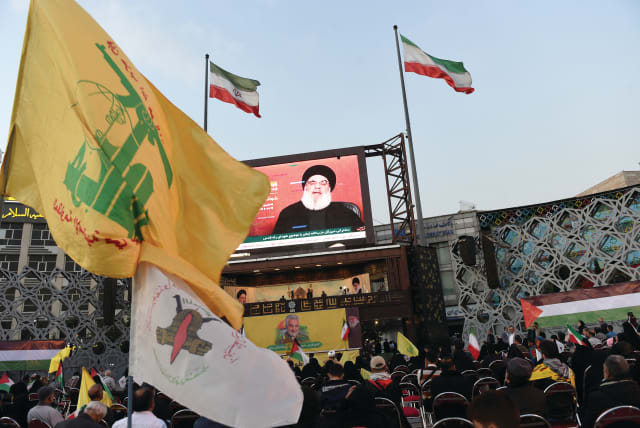Is Iran supplying Hezbollah with advanced new weapons? - analysis

The point of this report is to shed light on Iran’s threats and its attempt to move new capabilities to Hezbollah.
Iran may be seeking to supply Hezbollah with new types of weapons that the terrorist group could use to target Israel’s energy grid, according to the Kuwaiti media outlet Al-Jarida, which has a track record of reporting details about security developments in the region.
“Iran has rushed to supply Hezbollah with electromagnetic bombs that can paralyze communications and disable radars as the risk of the border confrontation with Israel turning into a full-scale war grows,” the recent report said. The same report made claims about pro-Iran groups seeking to attack the Golan if the war escalates.
It’s important with reports like this to try to understand what kind of message is being sent. In this case it is two messages.First, Iran is seeking to provide Hezbollah with new types of weapons to increase the threat to Israel. Second, Iran may seek to mobilize militias in Syria to threaten the Golan in order to create a second front in the event that escalation takes place on the Galilee front. The goal would be to try to threaten Israel from a new sector.
Al-Jarida claims to base its report on a source in the Corps’ Quds Force of the Islamic Revolutionary Guards Corps. It’s not clear why the IRGC would leak this information to a Kuwaiti newspaper. It may be that the source is not actually the IRGC but others who have an interest in putting these details into regional media.This could be a quiet warning to Iran, or it could be a warning to Israel. Al-Jarida claimed that the source says that Hezbollah already “possesses bombs and missiles carrying explosive ‘electromagnetic’ warheads, as the Revolutionary Guards successfully delivered these qualitative weapons to it a few days ago.”
Weapons can be used in a variety of ways
Supposedly, these weapons can be “launched from fixed launchers, and some of them can be carried by drones to reach any point deep inside Israel.”Hezbollah has attempted over the past nine months of clashes to show that its drones can launch munitions against Israel. In general though, Hezbollah does not possess drones that can carry and drop munitions. Instead, the drones are mostly kamikaze drones. It would be easier to launch a new type of warhead using a rocket launcher.Hezbollah has been escalating recently. It has carried out deeper attacks into Israel. It has used drones more often. It has also released videos taken by surveillance drones threatening sites on the coast of Israel, the Golan and also an Israeli air base. On Saturday Hezbollah launched a drone that flew out to sea and which was intercepted by an Israeli ship.Al-Jarida’s report said that Iran has been using Hezbollah to test “dozens of types of missiles and drones practically against Israel over the past ten months through its allies in the region and has collected a data bank on weapons that can penetrate air defenses.”This apparently is a reference not only to Hezbollah’s attacks but also the Houthis and Iranian-backed militias in Iraq.The report claimed that Israel “has revealed most of its cards and has not achieved any success other than destroying the Gaza Strip with American weapons, while the resistance front has retained its defensive and offensive plans and practical surprises.”Of interest, the report claims Hezbollah is hesitant to escalate too much because of “the internal circumstances in Lebanon.”This means Hezbollah is deterred by internal Lebanese politics. The report then goes on to elaborate about how Iran wants to provide Hezbollah with the know-how to target Israel’s energy sector as well as water resources.The source “concluded by saying that Israel’s threats to destroy Lebanon may backfire on hundreds of thousands of settlers [Israelis] who will be displaced from their northern areas if a comprehensive confrontation breaks out, after they face a disruption in basic services including water, electricity and communications, which may reach the point of replicating what Gaza is currently experiencing.”Hezbollah has said it is targeting Israel due to the war in Gaza. Hezbollah joined Hamas in attacking Israel on October 8, a day after the Hamas attack.The point of this report is to shed light on Iran’s threats and its attempt to move new capabilities to Hezbollah. Iran also appears to want to deter Israel from any action against Hezbollah by presenting Israel with threats from Syria.These kinds of reports may not always reflect reality, but they are important for messaging in the region about what the various groups are thinking.
Jerusalem Post Store
`; document.getElementById("linkPremium").innerHTML = cont; var divWithLink = document.getElementById("premium-link"); if (divWithLink !== null && divWithLink !== 'undefined') { divWithLink.style.border = "solid 1px #cb0f3e"; divWithLink.style.textAlign = "center"; divWithLink.style.marginBottom = "15px"; divWithLink.style.marginTop = "15px"; divWithLink.style.width = "100%"; divWithLink.style.backgroundColor = "#122952"; divWithLink.style.color = "#ffffff"; divWithLink.style.lineHeight = "1.5"; } } (function (v, i) { });

